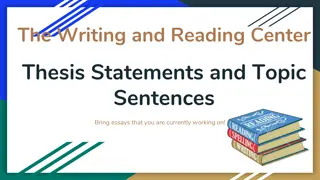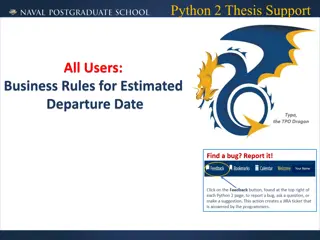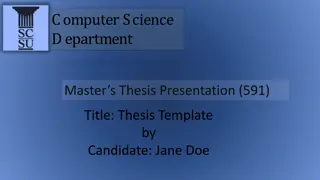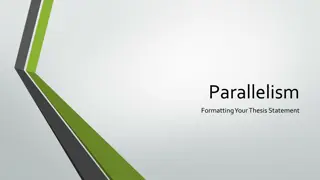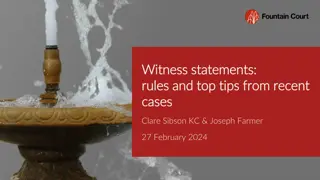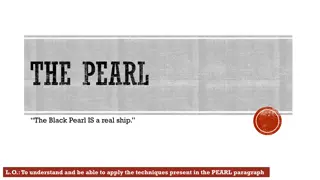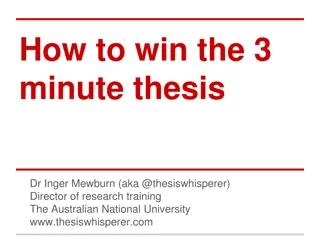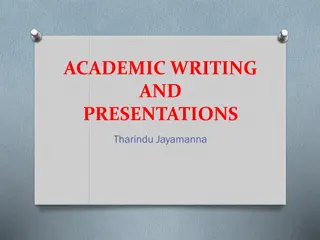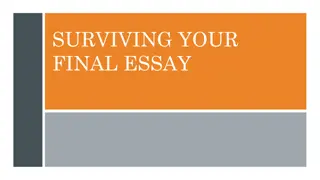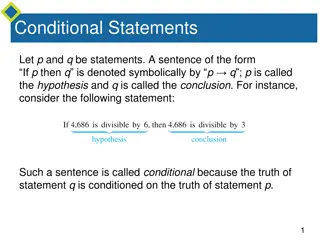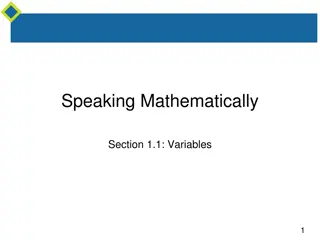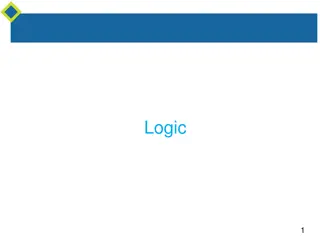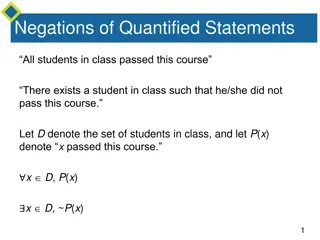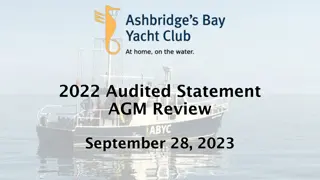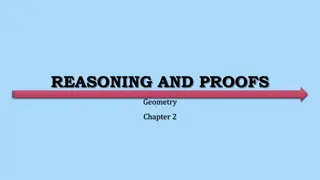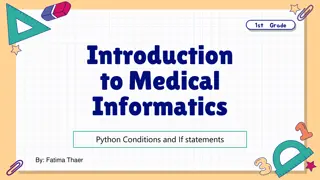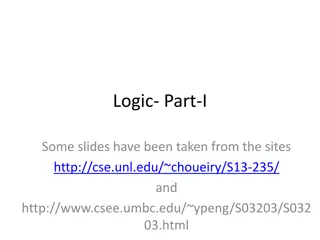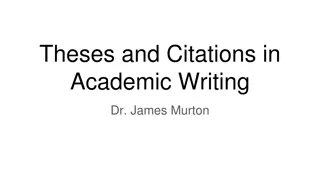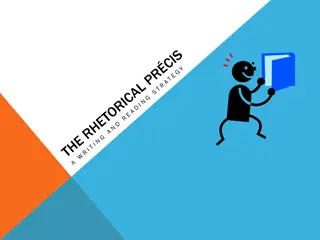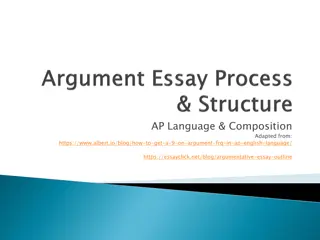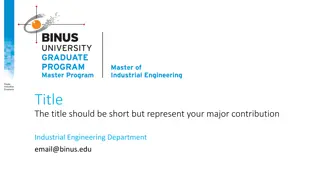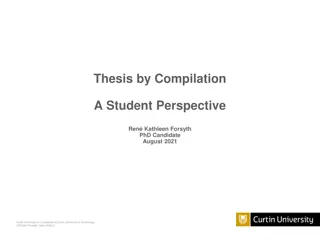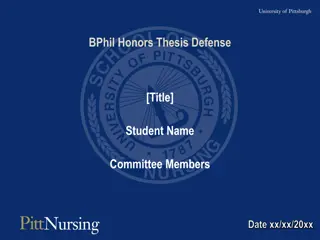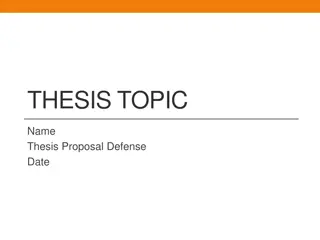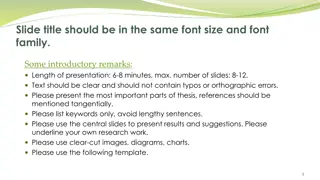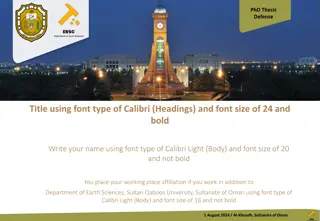Mastering Thesis Statements in Writing: A Complete Guide
Uncover the art of crafting impactful thesis statements with this comprehensive guide. Learn to begin with big ideas, distinguish between good and bad thesis statements, and structure your thoughts using a thesis statement framework. Dive into strategies for subduing stress while writing and excel in your academic endeavors.
Download Presentation

Please find below an Image/Link to download the presentation.
The content on the website is provided AS IS for your information and personal use only. It may not be sold, licensed, or shared on other websites without obtaining consent from the author. Download presentation by click this link. If you encounter any issues during the download, it is possible that the publisher has removed the file from their server.
E N D
Presentation Transcript
Wrangling with Writing Strategies to Subdue Stress Lori_Bowen@gwinnett.k12.ga.us
Begin with Big Ideas Writing Thematic Statements Start by determining several abstract words to express the primary ideas of the work (topics that the work is really about). Abstract words describe concepts or ideas that exist only in our minds like disillusionment, survival, oppression, cruelty, sacrifice, hubris, identity. Combine those abstract ideas with comments that reflect the author s observations about human nature, the human condition, or human motivation. In other words, what is the author s message about the abstract idea? Is he/she, for example, saying something about the qualities of people and/or commenting on society?
Good Thesis Statements What do good thematic statements do? state the theme as an insight into life Good Examples As one develops morally and psychologically, he learns his duty to his family and community. Insanity, given prolonged exposure to the isolation of the wilderness, seems an inevitable extension of disorder. Conrad, primarily through the example of the Company s chief clerk, shows how people can maintain order with the most mundane details of their lives while all around them disorder reigns. Conrad explores the question of what the alienation and loneliness of extended periods of time in a remote and hostile environment can do to men s minds. state the theme as a general comment on a subject draw a general insight from a character s behavior use qualifying words, such as sometimes, can, may, and often
Bad Thesis Statements What do bad thematic statements do? state the theme as a subject Bad Examples The theme is coming of age. state the theme as a maxim Love conquers all. state the theme as a moral or lesson You should not discriminate against anyone. Alienation makes everyone go insane. use sweeping generalizations with words like everyone, always, never, and all
Thesis Statement Framework (Thematic idea) (statement about thematic idea). Examples: (Courage) (allows people to attempt difficult tasks in their lives even when there is a chance of failing.) (Independence) (is necessary to grow up though it can be frightening.)
Next Up? Novels Summer Reading Assignment Choose three of the topics that follow. (Grouped topics count as one topic.) As you read, mark/highlight three passages for each topic you choose. (You will mark at least 9 passages total.) For each topic, find passages that 1) reveal the topic s emergence, 2) develop the topic, and 3) reconcile the topic. Each set of passages should represent the novel s comprehensive development, so you should have passages from the beginning, middle, and end of the novel.
Thematic Ideas in The Kite Runner Atonement/Redemption/Forgiveness Courage/Resilience Cruelty/Violence Discrimination Guilt/Remorse/Shame Home/Family Friendship/Loyalty/Trust Impact of the Past Parents and Children Quest Sacrifice
Thematic Statements Chart Student Sample
Practice with Passages Choose three of the thematic topics in Frankenstein. For each assignment, mark/highlight one passage for each topic (three passages per reading assignment). Each passage should also include clear examples of two literary elements: characterization, contrast, detail, figurative language, foil, foreshadowing, imagery, and/or tone. You may mark more than three passages. Find an electronic copy of the text, copy/paste your passages, and print/bring them to class on the day the reading is due. YOU WILL NEED THE PRINTED PASSAGES FOR THE CLASS ACTIVITY, AND THE ACTIVITY WILL BE GRADED!
Practice with Passages Choose one of the passages you brought to class. For that passage A) explain the context of the passage in a complete sentence; B) make an assertion about at least two literary elements in the passage and how they develop a thematic topic; C) explain your assertion, including quoted snippets from the passage in your explanation. You don t have to explain the meaning of the thematic topic, but you do need to explain what the passage says implicitly or explicitly about the topic. You need to include and draw a box around the literary elements and thematic topic from your assertion in the explanation.
Practice with Passages Choose two of the passages below. Follow the same instructions for these passages. For all three passages (one of yours, two of mine), choose from the following literary elements: characterization, contrast, detail, figurative language, foil, foreshadowing, imagery, and/or tone. YOU MUST USE EACH LITERARY ELEMENT AT LEAST ONCE, AND YOU MAY NOT USE ANY LITERARY ELEMENT MORE THAN TWICE. ADDITIONALLY, YOU MUST DISCUSS AT LEAST ONE THEMATIC TOPIC FROM EACH GROUP. This means you need to read all of the passages to determine prominent devices before you decide which passages you will explain. Student Sample


